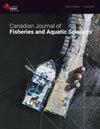大湖区金黄鲷(Alosa pseudoharengus)年级强度的同步性
IF 2.2
2区 农林科学
Q2 FISHERIES
Canadian Journal of Fisheries and Aquatic Sciences
Pub Date : 2024-06-20
DOI:10.1139/cjfas-2023-0322
引用次数: 0
摘要
加拿大渔业和水产科学杂志》(Canadian Journal of Fisheries and Aquatic Sciences),提前印刷。 鱼类的繁殖在年际间变化不定,预测难度很大。不同种群之间的年度招募通常具有区域同步性,确定这种同步性的驱动因素可能有助于揭示招募动态。我们利用 1968 年至 2022 年的年度评估调查数据,估算了劳伦伦三大湖(休伦湖、密歇根湖和安大略湖)种群的年级强度,从而研究了金黄鲷(Alosa pseudoharengus)招募的年际变化。我们首先确定了每个数据集设定年级强度的年龄。然后,我们使用混合建模方法,结合年龄、年级和采样年份来估计每个研究湖泊的年级强度。之后,我们评估了三个湖泊中年级强度的区域同步性,并评估了同步性的潜在气候驱动因素。我们的结果表明,金目鲷的年级强度是由 1 年龄决定的。我们的模型得出的金线鲃年级强度指数在三个湖泊之间是同步的,我们发现春夏度日是导致同步性的潜在区域驱动因素。这项分析凸显了气候条件对大型淡水系统中鱼类繁殖的潜在强大影响。本文章由计算机程序翻译,如有差异,请以英文原文为准。
Synchrony of alewife, Alosa pseudoharengus, year-class strength in the Great Lakes region
Canadian Journal of Fisheries and Aquatic Sciences, Ahead of Print.
Fish recruitment is interannually variable and challenging to predict. Annual recruitment is often regionally synchronized among populations and identifying drivers of such synchrony may help shed light on recruitment dynamics. We investigated interannual variation of alewife Alosa pseudoharengus recruitment by estimating year-class strength for populations from three of the Laurentian Great Lakes (lakes Huron, Michigan, and Ontario) using annual assessment survey data from 1968 to 2022. We first determined the age when year-class strength was set for each dataset. We then used a mixed-modeling approach incorporating age, year-class, and sampling year to estimate year-class strength for each study lake. Thereafter, we evaluated regional synchrony in year-class strength across the three lakes and evaluated potential climatic drivers of synchrony. Our results suggest that alewife year-class strength is set by age-1. Our model-derived indices of alewife year-class strength were synchronized among the three lakes, and we identified spring-summer degree-days as a potential regional driver of synchrony. This analysis highlights the potential for strong influence of climatic conditions on fish recruitment in large freshwater systems.
Fish recruitment is interannually variable and challenging to predict. Annual recruitment is often regionally synchronized among populations and identifying drivers of such synchrony may help shed light on recruitment dynamics. We investigated interannual variation of alewife Alosa pseudoharengus recruitment by estimating year-class strength for populations from three of the Laurentian Great Lakes (lakes Huron, Michigan, and Ontario) using annual assessment survey data from 1968 to 2022. We first determined the age when year-class strength was set for each dataset. We then used a mixed-modeling approach incorporating age, year-class, and sampling year to estimate year-class strength for each study lake. Thereafter, we evaluated regional synchrony in year-class strength across the three lakes and evaluated potential climatic drivers of synchrony. Our results suggest that alewife year-class strength is set by age-1. Our model-derived indices of alewife year-class strength were synchronized among the three lakes, and we identified spring-summer degree-days as a potential regional driver of synchrony. This analysis highlights the potential for strong influence of climatic conditions on fish recruitment in large freshwater systems.
求助全文
通过发布文献求助,成功后即可免费获取论文全文。
去求助
来源期刊

Canadian Journal of Fisheries and Aquatic Sciences
农林科学-海洋与淡水生物学
CiteScore
4.60
自引率
12.50%
发文量
148
审稿时长
6-16 weeks
期刊介绍:
The Canadian Journal of Fisheries and Aquatic Sciences is the primary publishing vehicle for the multidisciplinary field of aquatic sciences. It publishes perspectives (syntheses, critiques, and re-evaluations), discussions (comments and replies), articles, and rapid communications, relating to current research on -omics, cells, organisms, populations, ecosystems, or processes that affect aquatic systems. The journal seeks to amplify, modify, question, or redirect accumulated knowledge in the field of fisheries and aquatic science.
 求助内容:
求助内容: 应助结果提醒方式:
应助结果提醒方式:


